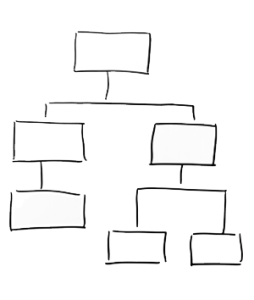This book was written using the teaching and learning principles of a constructivist paradigm, assuming a learner/learning-centered approach to learning. However, there are multiple schools of thought to explain how people learn – namely behaviorism, cognitivism, and constructivism, often referred to as the three pillars of learning theory. Each of these paradigms have different assumptions related to our understanding of what knowledge is and how people learn, which leads to different implications for the effective design of curriculum to enable and facilitate student learning.
Since the mid-to-late 20th century, behaviorism has been largely criticized and there has been a paradigm shift toward a learner/learning-centered approach most evident in. That being said, some behaviorist teaching practices, such as lecturing and practice & drill, are still widely used and continue to be popular approaches to teaching. The teaching practices based on a behaviorist understanding of how people learn might also be, in many circumstances, an effective and efficient way of teaching in higher education. As such, although the design principles and processes introduced in this book assume a learner-centred approach to learning and emphasize the critical role of learners’ agency in instructional design decisions, some effective design strategies, such as the use of learning outcomes and content sequencing, are grounded in behaviourism and cognitivism. also embed effective practices that have their roots in behaviorism and cognitivism. For example, learning outcomes may be based on the behaviorist assumption that learning is defined as behavioral changes that can be observed and measured (Murtonen, Gruber, & Lehtinen, 2017). However, learning outcomes are central to the constructive alignment design principle in that learning outcomes define the end points of students’ learning journeys. Course content, activities, assessment, and interactions are then chosen to create learning experiences that support learners in actively constructing knowledge and skills so that intended learning would happen.
In exploring and integrating such a diversity of theories and approaches, what remains most critical is not which paradigm that we subscribe to or the terminology that we use but rather what is the most effective set of design principles that will help your students, in your unique context, learn best. Many times, we might find that a mixed approach that takes into account the inherent diversity of abilities, resources, and circumstances, works better.
In Support of Thoughtful Blended and Online Learning Design

This eBook, Designing Online & Blended Learning for Impact, offers course instructors, instructional designers, policy makers, administrators, educational developers, and anyone who is interested in developing knowledge of and competencies in course design a fundamental overview of the critical components of the instructional design process. This eBook has been written as an introductory resource and is meant to be a companion guide to support the ongoing exploration and innovation inherent in instructional design processes. As a textbook, Designing Online & Blended Learning for Impact explores critical insights into the philosophy and utility of learner-centered design, emphasizing active learning strategies and a reflective approach to teaching and learning. As a resource, this book also includes a series of templates and tables to help organize and document your course design process, whether you are developing your first course or looking to consider innovative ways to update an existing session. The following video provides a brief overview of this book and its content.
Y. (2018, April 04). 16074 Teaching Commons eCampus Project Video 1 Frameworks. Retrieved April 12, 2018, from https://www.youtube.com/watch?v=VvPZteiYaXQ
Our goal is to offer a foundational approach to instructional theory and course design as a flexible, student-centered, multi-faceted process. We emphasize blended and fully online modes of instruction to extend our conversations beyond the face to face classroom, with the goal of examining the benefits of integrating technology and online tools into our teaching.
Why This eBook, and Why Now?

Developing competencies in course design, both face to face and using digital tools, is no longer optional for course instructors and administrators in higher education. The International Society for Technology in Education (ISTE) standards for teachers asks for the creation of significant learning experiences in both face to face and virtual environments. In Ontario, the Ontario College of Teachers Act stipulates using technology as a teaching tool as early as K-12 as required curriculum knowledge in a teacher education program. The Council of Ontario Universities also released a report on teaching and learning emphasizing the intimate relationship between teaching and learning, including how social media and other technologies can be leveraged for student success. A rapidly increasing number of instructors wishing to integrate technological tools into their teaching comes with an increased demand for support. The growing number of students enrolled in programs in educational technology, computers in education, and other related fields also adds to this demand (Ko & Rossen, 2010). This book aims to provide an introductory and accessible source of support for instructors looking to explore and integrate meaningful learning theory and the adoption of digital tools in their course design.
Learning Goals
Designing for Impact will enable readers to:
- Reflect on their teaching practices
- Formulate learning outcomes
- Structure and sequence a course or course module
- Select appropriate teaching activities and assessment tasks
- Design a systematic approach to evaluate quality of instruction
- Document and disseminate their insights and success
Chapter Structure and Organization of Content

This eBook is organized following a complete design and reflection cycle. Its content is arranged to introduce learning theories and design principles with a focus on explaining the steps and associated tasks involved in designing blended/online instruction that promotes student engagement and deep learning.
This eBook is composed of an introduction and five chapters. The first two chapters introduce design principles and learning theories and the remaining three chapters elaborate on key design steps and associated tasks in a sequential order. Carefully chosen practical examples and case studies are embedded to support worksheets, templates, and tips for designers (included in this eBook’s final chapter to illustrate the tasks involved). A variety of practical examples should aid learners in practicing the tasks involved in each design step. Reflective questions and potential next steps in the design process are also provided at the end of each chapter.
Each chapter is written as a self-contained unit so that it may be easily:
- Utilized or adapted in its entirety as a required textbook or supplemental reading for a undergraduate/graduate course
- Utilized or adapted as discrete chapters with each chapter used individually or in combination with other resources as needed
The eBook design pays special attention to the standards set by the Accessibility for Ontarians with Disabilities Act (AODA) including uncluttered and readable screen layouts, appropriate choice of fonts and highlighting, captioning on all videos and providing alternative text when images are used.

Defining terminology
This book uses a number of terms to define, discuss, and highlight important principles of effective course design. An overview of these important concepts is provided below. It is important to note that these definitions represent the views of the authors and are derived from a variety of sources. It remains the purview and agency of the reader to consider how, when, or if to incorporate these ideas into their teaching.
Instructional design: The systematic planning of instruction in which attention is given to a variety of theoretical and practical elements resulting in effective, efficient, and reliable instruction. (Kalman, H., Kemp, J., Morrison, G., & Ross, S. (2012).
Fully online learning: Instruction where most or all of the content is delivered online. Typically has no face to face meetings.
Blended learning: Instruction that blends online and face to face delivery. A substantial proportion of the content is delivered online: typically uses online components and has some face to face meetings. (Boettcher & Conrad, 2016)
Learning experience: Any interaction in which learning takes place, whether it occurs in traditional academic settings (schools, classrooms) or nontraditional settings (outside-of-school locations, outdoor environments. These experiences include traditional educational interactions (students learning from teachers and professors) or nontraditional interactions (students learning through games and interactive software applications). (http://edglossary.org/learning-experience/)
Teaching or instructional strategies/practices/approaches: The structure, system, methods, techniques, procedures and processes that a teacher uses during instruction. These are strategies the teacher employs to assist student learning (https://www.nwmissouri.edu/education/peu/pdf/studentteach/mopta/Task3Definition.pdf).
Educational technology: Technological tools and media that assist in the communication of knowledge, and its development and exchange (https://en.wikipedia.org/wiki/Educational_technology)
Digital technology: Electronic tools, systems, devices and resources that generate, store or process data. These include social media, online games and applications, multimedia, productivity applications, cloud computing, interoperable systems and mobile devices. (https://whatis.ciowhitepapersreview.com/definition/digital-technology/)
References
Boettcher, J. V., & Conrad, R. M. (2016). The online teaching survival guide: Simple and practical pedagogical tips. Hoboken, NJ: John Wiley & Sons.
Ko, S., & Rossen, S. (2010). Teaching online: A practical guide. New York, NY: Routledge.
Kalman, H., Kemp, J., Morrison, G., & Ross, S. (2012). Designing effective instruction (7th ed.). Hoboken, NJ: John Wiley & Sons.
Murtonen, M., Gruber, H., & Lehtinen, E. (2017). The return of behaviourist epistemology: A review of learning outcomes studies. Educational Research Review, 22, 114-128.
